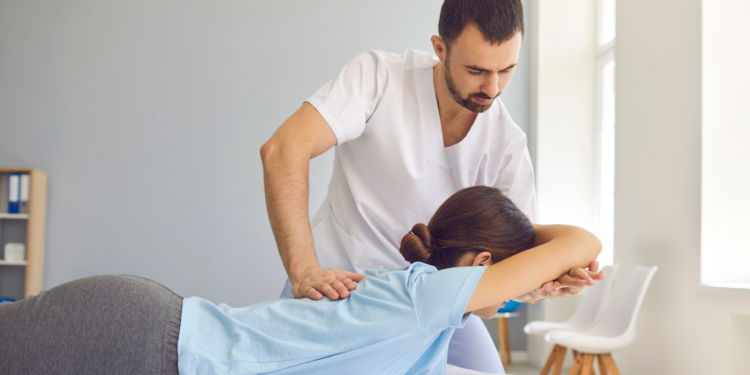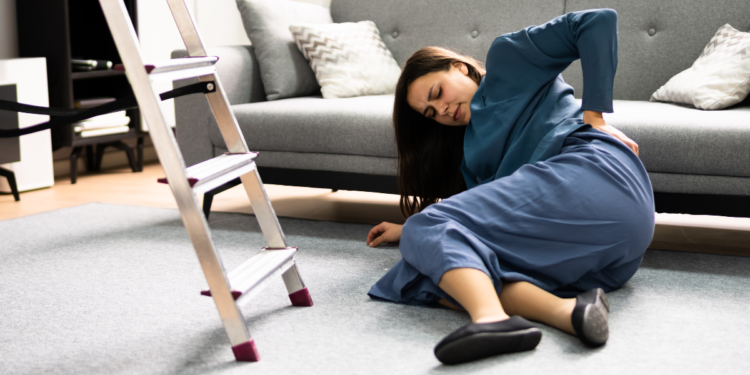Chiropractic care is a family affair. From birth to the golden years, doctors of chiropractic (DCs) offer natural solutions for pain relief, provide strategies to support optimal health and lay a strong foundation in the prevention of future health issues.
Not only can DCs offer targeted strategies that maximize joint function and deliver injury care for neuromusculoskeletal issues, they also provide consultation on other health topics like nutrition, exercise, posture and ergonomics so that family members of all ages can enjoy better health and well-being. For the young, the young at heart and all the steps in between, the benefits of chiropractic care can be found at every stage of life.
Fertility, Pregnant Moms and New Babies
As stated by The American Pregnancy Association, ‘Investing in the fertility and pregnancy wellness of women who are pregnant or trying to conceive is a routine matter for most chiropractors.’
From fertility, preparing the body for a healthy conception and pregnancy, to encouraging a healthy birth process, chiropractic care is uniquely positioned to offer safe, gentle approaches to support mothers and developing babies.
Studies in the Journal of Manipulative Physiologic Therapeutics (JMPT) and Obstetrics Gynecology respectively, have reported that nearly 50% of all pregnant women experience back pain during their pregnancy and up to 75% of women have back pain during labor.
DCs understand how variations in hormones can affect the synovial joints and soft tissues in pregnant women. Chiropractic works to optimize joint function and provide stability as the biomechanics of expectant mothers change during gestation. Positive effects of chiropractic on the neuromusculoskeletal system helps many women to:
- Maintain a healthier pregnancy and posture
- Improve sleep
- Control symptoms of nausea.
- Reduce labor and delivery time.
- Relieve back, neck or joint pain.
- Promote an uncomplicated delivery
The birth process itself can be a stressful event for babies. Their small bodies must respond to strong uterine contractions and travel through the birth canal. In situations of cesarean section, breech birth, shortened or wrapped umbilical cord, an unnatural rotation or pulling on the head, surgery or the use of tools like forceps, the trauma can be compounded. It’s an issue that has long been recognized.
The Journal of the American Osteopathic Association featured a ground-breaking article in 1966 by Dr. Viola Frymann that helped the world understand the problem. It stated that 90% of babies were born with some type of injury as a result of the birth process. Of those, 10% were born with profound injuries that could be readily observed even by an untrained eye. Only 10% of babies were born without any trauma. These statistics imply that 80% of newborn babies have suffered some sort of insult that may not be easily recognized and go unattended.
Examining babies from the cranium to the pelvis and optimizing joint function can help facilitate the best possible start in life. Maximizing neuromusculoskeletal dynamics not only helps with restricted motion or pain, it can also often benefit other underlying issues such as colic, sleep difficulties, feeding problems and more.
Children and Adolescents
As babies grow into children, a number of developmental events take place including rapid growth of the skeleton, brain development, fusing of the cranial bones, hormonal changes and so much more.
From toddlers to school-age, children are developing and increasingly engaged in a variety of activities that can affect the neuromusculoskeletal system. Learning to walk, riding a bike, growing pains, tumbles and falls, rough-housing during play, heavy backpacks and school sports can all contribute to creating imbalance or inciting injury.
These formative years of growth are also the peak time to watch for signs of scoliosis. As spine experts, DCs are often invited into schools for professional scoliosis screenings or to discuss backpack safety. Chiropractors are also on the front line in the battle against ‘tech neck.’ Also called ‘text neck syndrome,’ the condition is becoming a worldwide 21st-century issue for children and adolescents. This syndrome refers to the abnormal straightening or reversal of the spinal curve that comes with an abnormal forward lean of the cervical spine. It can lead to pain, headaches, muscle spasm, a change in the natural curve of the spine, premature degeneration of the spinal joints and ultimate deformity.
Young people are spending excessive hours a day on mobile devices texting friends, playing games, surfing the internet or watching videos. The resulting abnormal posture and joint damage is an issue of epidemic proportions for children and teens and may also be linked to other developmental, medical, psychological and social complications.
DCs understand the complexities of neuromusculoskeletal growth in children and how to minimize damage from strain on the spine caused by using mobile devices. Chiropractic care provides exams and adjustments to optimize joint function in the spine and extremities to help keep kids running at their full potential. DCs also offer exercises and techniques to maintain proper posture, provide guidance for ergonomic positioning and counsel families about tech time limits to help young people find a healthy balance with technology use.
Early Adulthood
As we traverse into adulthood in our 20s and 30s, entering the full-time workforce can usher in major changes in lifestyle and posture. If standing for repetitive work on an assembly line for eight hours a day, you may find yourself prone to a specific set of neuromusculoskeletal issues due to overuse. If sitting sedentary at a computer desk, a different but just as important set of concerns will arise.
DCs are advocates and valued partners for a variety of wellness initiatives focused on health and prevention in the workplace. Not only do they offer spinal and extremity adjustments to support healthy joint function, they can also recommend on-the-job workstation ergonomics, posture techniques, exercise and muscle balance strategies to naturally keep the spine healthy for years to come and help you keep your youthful edge.
Early to middle adulthood is also a time where many people may become ‘weekend warriors’ and physically ‘over-do’ it when there is time away from the job. This is often a time when people choose to have children too. As dads and moms are becoming sports stars on the weekends and trying to keep up with lifting, carrying, running and jumping with little ones it also becomes a time for inadvertent joint strains. Prompt care after a strain injury will help you heal faster and get back into the action.
Very important in this stage of life it is encouraged to be mindful about future bone health and conditions like osteoporosis and arthritis. A 2017 study in the European Journal of Rheumatology reported that worldwide, it is estimated that the number of patients with hip fractures stemming from osteoporotic bone fragility is more than 200 million. This is significant as hip fractures are associated with morbidity, mortality, loss of independence and financial burden later in life.
Though it may seem early to think about it, osteoporosis is called a ‘silent disease’ process. This means it often isn’t detected until the damage is done and there is no cure. Early detection and preventative measures are paramount and it is never too early to emphasize joint health and start regimens to keep bones strong as we age.
Middle Age
As individuals enter middle age, chiropractors can help with the new sets of concerns that come with it. Changes in hormones and lifestyles in mid-life are a main focus as bone and joint health comes to center stage along with weight gain and other symptoms.
Some women may enter the preliminary hormonal changes of perimenopause as early as their 30s. Others may not go through the change and ultimate cessation of menses until their late 40s and early 50s. As symptoms of menopause occur such as irregular periods, hot flashes, mood changes and muscle mass changes, it is important to realize that bone density has a higher risk of depletion as your hormones deplete.
For men, a change of hormones also occurs, though differently than in women. Women’s hormones plummet during the relatively short period going through menopause. In men, the production of testosterone and other hormones declines steadily over a span of many more years. Low levels of testosterone in older men may often go unnoticed, but they can be detected by a blood test. Symptoms of declining hormones in men may include but not be limited to concerns such as: height loss, low bone mineral density, sweats, ‘man breasts,’ low libido, mood changes, reduced muscle bulk, reduced strength and an increase in body fat.
With the natural progression of these changes in hormones, musculoskeletal pain and arthritis are recognized as being increasingly common after you pass the age of 50. In addition to neuromusculoskeletal care to reduce pain and maximize joint function, a DC can help individuals analyze their specific risk factors for osteoporosis and the possible need for a bone screening study. Your DC can also recommend nutritional foods and supplements targeted to support the metabolic needs of your bones, as well as help you devise a plan of specific weight-bearing exercise to help maintain healthy bones and strength over time.
The Golden Years
In our golden years (generally considered around age 65 and beyond) chiropractic care strives to enhance quality of life and promote independence by helping patients maintain optimum mobility and stability in the joints. As our bodies age we find that joints stiffen and balance naturally declines. These factors increase the risk of falling and make the possibility of suffering an injury more common. Older adults are also particularly vulnerable to back pain. A 2016 study in the journal Clinical Interventions in Aging listed back pain as one of the top two reasons that elderly patients visit a doctor’s office.
DCs continue to increase in popularity with older adults as they utilize gentle low impact techniques that are safe and effective to maximize joint function which can significantly reduce pain and reduce the need for surgery or drugs that could have potentially dangerous side effects. DCs also can provide recommendations for nutritional foods and supplements targeted to support the metabolic needs of older bones, offer solutions for tight muscles, as well as help you devise a plan of specific weight bearing exercise to help maintain strong bone health and enhance balance and stability to reduce fall risk.
Natural Care for the Entire Family
Doctors of chiropractic are primary care neuromusculoskeletal specialists with extensive diagnostic skills and are well-trained to offer a drug-free hands-on approach to healthcare that includes patient assessment, ordering special studies, diagnosis, management and referral or co-management when indicated. DCs are specialized to:
- Analyze and adjust the joints of the spine and extremities to optimize function
- Recommend therapeutic and rehabilitative exercises
- Recommend or apply a wide-range of soft tissue mobilization techniques
- Recommend or apply physical modalities such as heat, laser, ultrasound, electrotherapies, traction
- Provide nutritional, ergonomic and lifestyle recommendations
Chiropractic care works toward short and long-term goals to go beyond pain relief to promote prevention and enhance quality of life. Ask your DC to develop a comprehensive care plan tailored for each member of your family to provide a safe gentle approach to optimize health at every stage of life.










